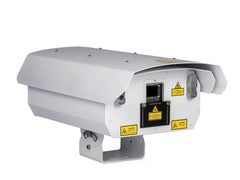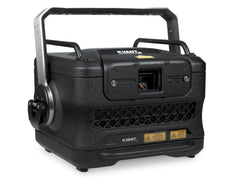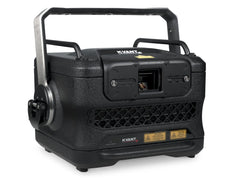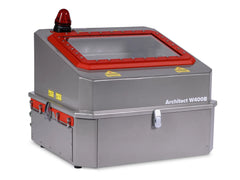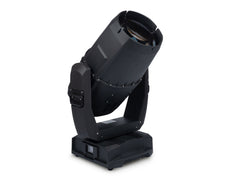There are so many different types of laser light show projectors, and laser manufacturers on the market today. Trying to determine which brand, model, or type of laser projector you need can be quite stressful, as the components of your laser can directly impact the quality of shows you’re able to create.
In this Laser Light Show Projector Purchasing Guide, we’ll provide you with a ton of insight about laser projector specifications to help you understand what to look for when buying or comparing laser show projectors.
Laser Powers & How to Interpret Them
Laser show systems come in a wide variety of power levels, and the overall power output from a laser projector can be one of the most important factors to consider when choosing the right laser system for your desired application.
It is important to note that the overall “Wattage”, isn’t the only determining factor for a laser’s apparent brightness.
Laser powers are generally specified in terms of “Watts (W)” or “milli-watts (mw)”.
For example, 1W= 1,000mw.
Laser specifications can be deceiving depending on how they’re written, so you’ll need to be careful and make sure that when you’re looking at the rated power it has labeled, that you’re getting the actual output power that you need and are paying for.
When looking at different laser projection systems, manufactures typically will not give you the output power of the laser at the output window. This is the measurement of power you will receive once you’re outputting from your laser, not the power on the inside of the laser. This is something that is extremely important to know if you’re ever planning on doing an audience scanning laser show.

The reason that manufactures typically label their laser projectors like this is for a cheesy “marketing and sales” tactic to make their laser projectors look more powerful than they are. As their products are likely cheaply made and wouldn’t produce those powers advertised otherwise.
Here are some terms to be weary of when comparing different laser projectors and brands.
Minimum / Maximum output power
In this case, the maximum laser power is what is produced inside of the laser - It is NOT what you will get at the output window. As every time a laser hits an optic/mirror, it has a small loss of power.
Apparent brightness
This is a generalized term, and it does not mean your laser actually has the power labeled. You might see certain suppliers say their laser has an “apparent brightness of 1W”.
This doesn’t mean the laser actually has 1W. So you need to make sure that if your supplier uses the apparent brightness technique for specifying the laser’s power, that you ask them for the real output power of the laser projector, at the output window.
All laser light show projectors sold by Pangolin have their specification for power listed at the output window. So you will get the exact laser power specified, and many times even more!
Choosing The Right Laser Power
Deciding on the amount of power you need in a laser can also be confusing at times, as there so many sizes of wattage listed.
We’ve created a basic guide of what power is right for a give application noted below.
Low Power Lasers (500mw - 3W)
Well suited for indoor shows, such as small to medium size clubs, home use, and most small events.
Medium Power Lasers (3W - 12W)
Well suited for medium to large scale indoor venues, as well as outdoor shows (for 6W+). These are also well suited for aerial & beam projections outdoors, typically at night.
High Power Lasers (15W - 40W+)
Well suited for large scale indoor venues such as stadium size shows, as well as large outdoor shows such as festivals, stadiums, long distance aerial projection, large outdoor graphics projections, etc.
Laser Colors
Most laser projectors have one to three laser modules (red, green, and blue) inside. Though the international standard provides for up to 6 color channels to control up to 6 different color laser modules.
A laser module’s color is determined by its wavelength, and the laser diodes inside. Which are measured in nanometers (Nm). All 6 international standard colors are noted below.

That being said, the vast majority of laser light show projectors on the market use three color sources to create what we call “RGB” laser projectors. With RGB based laser projectors, you can create nearly any color in the spectrum.
When working with RGB laser projectors, it is very important to have a system with an even balance of red, green and blue laser sources inside, as this is a crucial element that allows you to create a wider variety of colors from the laser projector.
A good ratio of red, green, and blue is about 20-30% red, 30-40% green, and around 40-50% blue. Green is the most visible color for lasers. Blue is also the cheapest laser source.
So it is common for some budget manufacturers to advertise high power lasers, but use a lot of blue. This is generally not good, because even though you have more power, you have unbalanced colors.
And in reality, an evenly balanced laser with good color combination will appear brighter to the human eye, than even a higher power system with an uneven balance of red, green, and blue. So when comparing brightness, it is not just about “power”, color balance, quality optics, and internal components, are all as equally important.
Laser Analog and TTL Modulation
There are two types of modulation when it comes to lasers. These include “analog” and “TTL” based systems. Without getting too technical, if you use an analog laser projector with good linear modulation, you can create millions of different color combinations and evenly fade in and fade out between those colors when creating different laser effects.
If you have a TTL based laser, you are limited to only seven colors in total, and you cannot fade in and fade out across different colors. Budget level lasers or those which are lower in price are usually TTL based. While more professional lasers tend to be analog modulated.
Modulation and Blanking
This is an externally caused by a change in laser power, which turns the laser on and off and also allows for the fading of colors.
Blanking, or disabling laser output in a specified area when projecting an image is commonly used when drawing laser animations to separate image components, so they are not connected by a low power line.
For example, if the word “TEXT” is projected, a properly blanked laser with analog response and a good linear balance would turn off (0% power) between each letter of the word, allowing you to clearly see each letter in the projected image.
Whereas in less professional laser systems, you will see a line or tail going through part of word, as illustrated in the “TEXT” example below.
This is good (analog modulation, linear balance).

This is bad (poor modulation, blanking lines visible).

Understanding Optical Scanning Specifications
Most laser projector manufacturers use the term “KPPS” or Kilo Points Per Second, when defining optical scanning speeds. So if you see specifications like “20K, 30K, 40K, 60K, etc., when looking at the speed of your laser, this is the speed in which your laser's scanner can produce.
Another factor that is just as important as the speed of the optical scanning system is the angle which it is specified at. The optimal scan angle for most laser projectors is 8°.
This standard was set by the International Laser Display Association, who oversees most laser specifications that are set on the market currently. We use 8°, as this is generally the smallest scan angle you would need to use in a real world scenario.
For example, you might see 30K @ 8° or 40K @ 8°.
But again, make sure you are closely watching the angle at which the speed is defined, because that is just as important as the KPPS speed being defined. If you see a scan speed specified at less than 8°, or if you do not see any angle specified, be cautious.
Some people will say “30K @ 4°”... Again in this specific case, you want to be careful. Because 4° is not the correct angle to measure a scan speed at. The ILDA test pattern which is used to measure scan speeds was designed to be measured them at 8°.
Therefore when measured properly, a specification such as "30K at 4° does not actually have a "30K" scan speed. With that kind of specification, you cannot expect to have a true "30K" projector, as denoted by the international standard.
Another important thing to consider when looking at optical scanning systems on your laser show projector, is the optical degrees it can project at, on an X and Y axis.
For example, some people will say +/- 60° optical on the X and Y axis. You want to take note of this, because the angle you can project at directly effects how large of a projection area you can cover with a single laser. Better lasers on the market will start at +/- 60° optical on the X and Y axis.
Here is an overview of optical scanning specifications, and how they related to the effects you can create.
- 30K @ 8° (+/- 60+° optical on the X and Y axis) - This will be well suited for laser beam effects, and it can also be used for basic laser graphics, text and logo projections. The +/- 60° optical is a pretty large scan angle, and will allow you to cover a relatively wide projection
- 40K @ 8° (+/- 60+° optical on the X and Y axis) - This will be well suited for laser beam effects, and it will also give you sharper looking laser graphics, text, and logo projections.
- 50K @ 8° (+/- 60+° optical on the X and Y axis) - This will be well suited for laser beam effects, and it will also give you very sharp looking laser graphics, text, and logo projections.
- 60K @ 8° (+/- 60+° optical on the X and Y axis) - This will be well suited for nearly any type of laser display you might wish to create. However, there are only a few optical scanning which can really achieve this speed.


